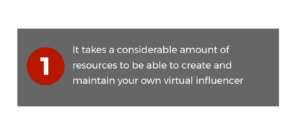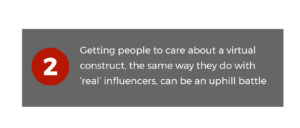Picture an influencer that you can fully control. One that adapts to meet any and all of your marketing plans, and is not likely to be caught in a scandal. Sounds like a dream? Well, virtual influencers are bringing that dream closer to reality. Brands like Samsung and Prada have created their own virtual influencers. According to reports, they can offer up to three times more engagement rates than normal influencers. Are they something you should include in your future marketing strategies? Read on, and decide.
What are virtual influencers?
Virtual Influencers are computer-generated characters that are made to look as human as possible, with realistic and unique personality traits and features. From Miquela Sousa with her gap-toothed smile to Nobody Sausage and his colorful wigs, there are endless possibilities for personalization. You may have heard of the call for ‘thumb-stopping’ content online; that is unique content that will make your audience on social media pause in their tracks and engage with your content. Virtual influencers, to some degree, are an embodiment of that, as they rise above the noise on social media platforms thanks to their carefully crafted looks and storylines.
What are some examples of virtual influencers?

From partnering with the World Health Organization to having songs on Spotify, there seems to be no limit to what virtual influencers can do. Virtual influencers are from all parts of the world and come in all shapes and sizes! There are some easily recognizable ones like Minnie Mouse, who boasts 727k followers on Instagram and who shares snippets from her daily life such as going on walks, and dates with Mickey. Noonoouri advocates for green living and cruelty-free fashion, and has partnered with brands such as Versace. Lu, with 6 million followers on Instagram, is the brand spokesperson for Brazil’s Magazine Luiza. Every day, new computer-generated characters are born and enter the game.
How can brands benefit from this technology?
For brands, the benefit of virtual influencers lies in control. Because any brand can create its own virtual influencer, this type of marketing provides the brand with possibilities and benefits that no other type can.


These are near-impossible feats with ‘human’ influencers. As the brand’s own creation, a virtual influencer offers reliability that would be hard to come by otherwise.
And for the brands that are not able to create their own virtual influencer, they can work with an existing virtual influencer. This brings most of the benefits that traditional influencer marketing brings, such as tapping into the influencer’s audience. As we’ve seen above, some of the virtual influencers have hundreds of thousands of followers. Even with this option, it is still possible for brands to have way more creative control over the collaboration than they would with ‘human’ influencers.
Let’s not forget too, that virtual influencers can’t get sick, or be unavailable in the way that humans can.
Are there any cons?
Yes, there are.


Another potential drawback is that virtual influencers may be seen as a tool for fake news and misinformation. From a marketing perspective, using deepfakes and eerily realistic audio to build your virtual influencer’s persona is risky. Brands seen to be creating “fake” content with computer-generated influencers can be vulnerable to outrage from users. At the end of the day, people like authenticity. Authenticity leads to connections and connections lead to sales.
Virtual influencers look like video game models, but newer versions can be hyper-realistic. According to this Raconteur piece, “if it eventually becomes impossible to tell the difference between a real and a virtual influencer, brands will need to decide if their use really matches their values, such as authenticity and honesty.”
Are Virtual Influencers the future of influencer marketing? Possibly. It all boils down to your marketing strategy. For brands considering using this technology, a great start can be working with an existing one to experiment. This can help with gauging its performance before taking the leap into creating your own custom one.
Virtual influencers can be effective in targeting more specific audiences, gaining access to new audiences, and generating proof of influence. As virtual influencers become more established in the marketing industry, we will likely see even more involvement by major brands and marketers around the world.
Let’s start a conversation about taking your digital marketing to the next level with help from our specialist team.





